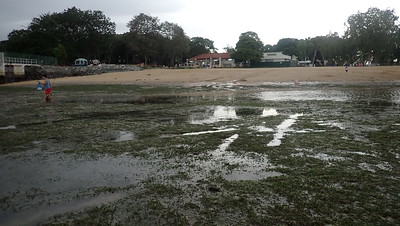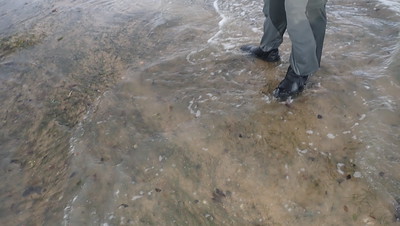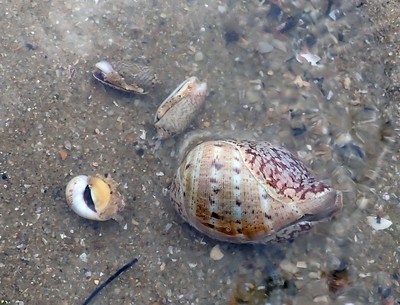There is a shallow lagoon at East Coast Park which has slowly been taken over by seagrasses. Although the high shores were crowded during this long weekend, we had the intertidal almost entirely to ourselves during this brief evening tide.
A long narrow sand bar sticks far out from the high shore, with lush seagrasses growing on the edges into deeper water. I saw many furrows that might be dugong feeding trails. Also many interesting marine life, while the team encounters a stonefish!
There were many trails in the seagrasses on the sandbar far from the high shore. The trails were rather straight though, so they might be a result of some human activity. But might also be be dugong feeding trails?
Towards the high shore, there were also similar trails. I saw similar trails on our last visit here in May 2021.
Dugong feeding trails are formed when dugongs chomp up seagrasses including their roots, leaving a shallow meandering furrow of about equal width and depth. Here's a closer look at the furrow in the seagrass meadow that I saw today.
We first saw seagrasses growing here in Jun 2013. Over the years, they have been thriving. As on my last survey here in May 2021 and Jun 2016, there were still lush growths of Needle seagrass (both narrow and broad leaf blades) and Spoon seagrass (large leaf blades). The patches of Serrated ribbon seagrass and Noodle seagrass that I first saw in May 2021 are still there - these two species are not as commonly seen on our shores. For the first time today, I saw two small clumps of Tape seagrass with long leaf blades near the high shore.
I was delighted to see many of our favourite seagrass echinoderms here. The most abundant remains Tiny red sea cucumbers (which are not babies of bigger sea cucumbers and do not grow any bigger). I saw a few small Thorny sea cucumbers, and some uprooted Ball sea cucumbers. There were also some Fan clam shells and I saw one Swimming anemone. Unlike our last survey in May 2021, we didn't see any sea stars or sea urchins.
Che Cheng found the skeleton of Luzon heart urchin (Brissopsis luzonica) - which we don't commonly encounter. There were also Thick-edged sand dollars which are not commonly seen too.
Buried on the sand bar were many kinds of snails. Like Weasel olive snails and commonly seen moon snails. Some are not often seen on our shores like the Fig snail, Bosom moon snail and Eggwhite moon snail.
What is the fate of this shore?
These shores slated for massive reclamation outlined recently in the Long-Term Plan Review. There were additional details, plans for a 'Long Island' opposite East Coast Park is now official. In addition to more reclamation along that shoreline, already unveiled in 2013.
See for yourself the amazing marine life on East Coast shores before they are gone! Corals, seagrasses and other marine life have naturally regenerated on the artificial shores at East Coast Park. These shores are easy for ordinary people to explore at low spring tide. More details in "East Coast Park - Surprising intertidal adventures for the family".
Photos by others on this survey
Loh Kok Sheng
Kelvin Yong
Che Cheng Neo









